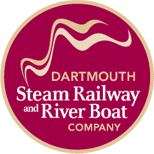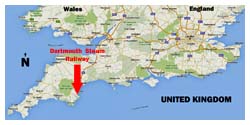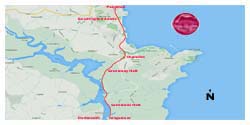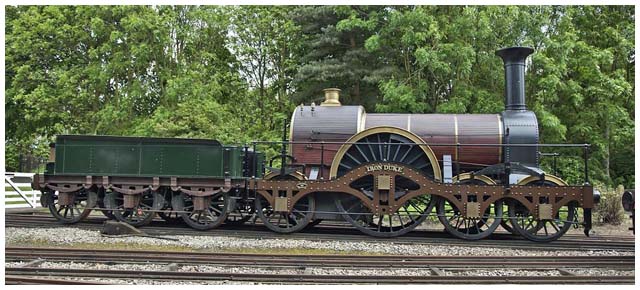

The Dartmouth Steam Railway doesn't go to Dartmouth. It terminates at Kingswear, directly across the Dart River harbour but... the railway fare includes the price of the passenger ferry ride. Perhaps their full name should be mentioned now, it's the Dartmouth Steam Railway and River Boat Company as they also operate a paddle wheel steamer called "Kingswear Castle" plus the more conventional "Cardiff Castle". The opposite end of the rail line occurs at Paignton, 6.7 miles to the north, where their "Queen's Park" station lies next to a National Rail connection with the rest of Britain. Great Western Railway trains end their journey here at Paignton but call at 270 stations located in Devon, Cornwall, Somerset, Bristol, Berkshire, Wiltshire, and Gloucestershire with their London terminus at Paddington Station.
It was 1861 when the Dartmouth & Torbay Railway opened between Torbay and Brixham Road Station (named Churston station today) finally reaching Kingswear in 1864. It was built as a broad gauge railway 7 feet 1/4 inch width between the rail head's. During 1872 the line was taken over by the South Devon Railway (SDR) followed by the Great Western Railway (GWR) which gobbled up the SDR in 1876. Two years later Brixham Road Station became known as Churston retaining that name today. The broad gauge was replaced by standard gauge (4 feet 8 1/2 inches) in 1892. Nationalization into British Railways occurred in 1948 spelling the end to the GWR. (Until 20 Sep 2015 when First Group, a privatized train operating company, resurrected the name Great Western Railway, what goes around comes around, it seems.)
The Ministry of Transport proposed closing the line in 1968 but instead it was purchased by the Dart Valley Railway Company in 1972. This company also operated a heritage railway, what is now known as the South Devon Railway between Totnes and Buckfastleigh. A new station, independent from British Railways, was opened at Paignton to service the line which was then known as Torbay Steam Railway. This was subsequently changed to the Dartmouth Steam Railway which is owned by Dart Valley Light Railway Company plc.

 Paignton - Paignton lies in the county of Devon, or Devonshire, known as "The English Riviera", a popular holiday destination with its zoo, Splashdown Quaywest, beaches, Paignton Pier, boat rides, and other attractions including the railway. Torbay Road, leading off the beach towards town center, has a carnival midway atmosphere to it. Paignton's station, known as "Queens Park", is the northernmost terminus for the Dartmouth Steam Railway lying next to the First Great Western station. The brick station contains a ticket office, souvenir shop, and cafe. A shed for light maintenance of the locomotives and carriages is located at the south end of the station.
Paignton - Paignton lies in the county of Devon, or Devonshire, known as "The English Riviera", a popular holiday destination with its zoo, Splashdown Quaywest, beaches, Paignton Pier, boat rides, and other attractions including the railway. Torbay Road, leading off the beach towards town center, has a carnival midway atmosphere to it. Paignton's station, known as "Queens Park", is the northernmost terminus for the Dartmouth Steam Railway lying next to the First Great Western station. The brick station contains a ticket office, souvenir shop, and cafe. A shed for light maintenance of the locomotives and carriages is located at the south end of the station.
Churston - The Churston Station of stone construction was originally named Brixham Road when it was built in the 1860s for the Dartmouth & Torbay Railway. Churston lies at the summit of the railway. Since purchase by the Dart Valley Light Railway Company plc the area has become an important maintenance center for the railway with their carriage work shop, heavy repair locomotive shop, and even a turntable on the north side of the A379 road. Brixham, which lies east of Churston and once connected by rail, would benefit from Great Western rail service. If such a connection were to be built then track between Paignton and Churston might require doubling.
 Goodrington Sands - Travelling south from Paignton the first scheduled stop on the line is Goodrington Sands, next to the beach and Splashdown Quaywest water park. This mainly rust coloured sandy beach has clean water with safe swimming conditions. Small shacks sporting many coloured doors line the top of the beach parallel to the railway line.
Goodrington Sands - Travelling south from Paignton the first scheduled stop on the line is Goodrington Sands, next to the beach and Splashdown Quaywest water park. This mainly rust coloured sandy beach has clean water with safe swimming conditions. Small shacks sporting many coloured doors line the top of the beach parallel to the railway line.
Greenway Halt - Appears to exist as a stopping point for visitors to Greenway Estate, the historic home of Agatha Christie who you will recall was the author the 1934 novel "Murder on the Orient Express". Greenway Halt itself is little more than a short platform only long enough for two carriages. This is a request stop at certain times so passengers should check with the guard prior to arriving. It's about a mile from the halt to the Greenway Estate but there is a bus service running every 40 minutes. Immediately south of the halt lies the 495 yard long Greenway Tunnel.
Britania Halt - Shortly after exiting the Greenway Tunnel southbound the line crosses the Maypool Viaduct over a low lying swampy and forested area. Father along the line skirts the Noss on Dart Marina across a fill over Noss Creek. Next comes a grade crossing where the A379 road connects with the Upper Dartmouth-Kingswear car ferry. Britania Halt is located here. Another lower Dartmouth-Kingswear car ferry is located in Kingswear immediately next to the Kingswear Station. From Britania Halt grade crossing southwards, the line hugs the shoreline of the Dart River until reaching Kingswear.
Kingswear - The southern terminus of the rail line ends abruptly at the stub tracks under the station platform. It wasn't supposed to be this way. The early builders of the line envisioned a crossing of the Dart River further upstream near Greenway and running down the west side of the river to reach a station on the jetty. They were so confident of this they constructed the station prior to completing the right-of-way. Local landowners and the Admiralty objected to a bridge across the Dart River and blocked construction. Parliament granted permission to build along the east side of the Dart to Kingswear in 1857. So now there's a railway station without any tracks resting on the jetty in Dartmouth. Currently it's a restaurant known as the "Station Restaurant", what else would you name it? Next to the Kingswear platform you will see a typical signal box that isn't a signal box. It's a replica of a Great Western Railway signal box containing modern offices for railway administration, the building of which stirred up quite a controversy. * See the news article "Secretary of State's Powers Sought in Signal Box Revolt".
The railway has 7 steam locomotives in various states of repair, overhaul, or reconstruction. Please refer to their web site for the latest serviceability.

4277 "Hercules" - 2-8-0T Consolidation GWR class 4200 built at Swindon Works in 1920.
4555 "Warrior" - 2-6-2T Prairie GWR class 4500 built at Swindon Works in 1924 and currently out of service.
5239 "Goliath" - 2-8-0T Consolidation GWR class 5205 built at Swindon Works in 1923 and currently out of service.
5542 - 2-6-2T Prairie GWR class 4475 built in 1928 is a visiting engine.
7820 "Dinmore Manor" - 4-6-0 Ten-Wheeler GWR class 7800 built in 1950 on loan for the 2016 summer season.
7827 "Lydham Manor" - 4-6-0 Ten-Wheeler GWR class 7800 built at Swindon Works in 1950 whose boiler certificate expired in 2015.
75014 "Braveheart" - 4-6-0 Ten-Wheeler BR standard class built at Swindon Works in 1951 expected serviceable in 2016.
There are four diesel locomotives on the line, mostly shunters and one BR class 25.
15 Jun 2009 - Extending Rail Link Would be On Track
28 Aug 2011 - The West Country's Best Steam Railways
24 Jan 2013 - Secretary of State's Powers Sought in Signal Box Revolt
24 Apr 2014 - Full Steam Ahead for Dartmouth Steam Railway and...
15 Jun 2014 - A Dartmouth Steam Train on the Devon Coast
24 Jul 2014 - Experience the Footplate Thrill as you Drive the Steam Train
24 May 2015 - Fire Crews Tackling Steam Train Track Blaze in South Devon
5 Dec 2015 - Emergency Services Tested in Mock Train Crash
28 May 2016 - Dartmouth Steam Railway Fireman Prepares to Cycle for Charity
5 Jul 2016 - The Rebirth of the Great Western Railway
22 Sep 2016 - Steam Enthusiast Falls in Front of Train While Taking Photos


Dartmouth Steam Railway
Cornwall Railway Society
The Broad Gauge Society
The Dartmouth Express
The Torbay Express
Hookhills Viaduct Sounds
Dart Valley Railways DVD
Kingswear Castle Paddle Steamer
River Dart Steamboat Company
GWR Archive (virus detected)
The Story of the GWR
GWR Modelling
Didcot Railway Centre
Train Simulator Riviera Line
National Rail
Great Western Railway
Visit Devon
Agatha Christie
 Dartmouth Steam Railway Souvenir Guide BookG.M. Kichenside, A. Pooley, and P. Roach2014Dartmouth Steam Railway & River Boat CompanyPaperback20 pages, £3.50A small comprehensive souvenir booklet with many small photographs and drawings. Well done and well priced considering the amount of detail enclosed.
Dartmouth Steam Railway Souvenir Guide BookG.M. Kichenside, A. Pooley, and P. Roach2014Dartmouth Steam Railway & River Boat CompanyPaperback20 pages, £3.50A small comprehensive souvenir booklet with many small photographs and drawings. Well done and well priced considering the amount of detail enclosed. A Visitor's Guide to the Dart Valley
A Visitor's Guide to the Dart Valleyand Torbay & Dartmouth RailwaysAuthor unknown1985Dart Valley Light Railway Company plc.Paperback32 pages, £1.90A small souvenir booklet.
 Great Western Railway: A HistoryAndy Roden2011Aurum Press.Hardcover306 pages, $33.45"God's Wonderful Railway" it was called if you were a fan. The "Great Way Round" if you took a more jaundiced view of its circuitous branch lines. But 175 years after its foundation, the Great Western Railway company is remembered with the most nostalgia, even love, of all Britain's pre-nationalization railway companies. It built and ran the great main line from London to the West Country and Cornwall. It was engineered by the greatest of them all, Isambard Kingdom Brunel, who built such wonders as the Box Tunnel and the Saltash bridge. Its steam locomotives were designed by great men like Churchward and Hawkesworth. But also it had wonderful stations like the soaring Paddington and Bristol Temple Meads, as well as innumerable idyllic country halts with little more than a pagoda shelter and a couple of milk churns awaiting collection. Its engines were painted a deep green, its carriages chocolate and cream. Its Cornish Riviera Express train, and the line alongside the beach at Dawlish sprayed by the waves, became the stuff of legend. Now Andy Roden has written the first comprehensive history of the GWR for 20 years, to tie in with its 175th anniversary.
Great Western Railway: A HistoryAndy Roden2011Aurum Press.Hardcover306 pages, $33.45"God's Wonderful Railway" it was called if you were a fan. The "Great Way Round" if you took a more jaundiced view of its circuitous branch lines. But 175 years after its foundation, the Great Western Railway company is remembered with the most nostalgia, even love, of all Britain's pre-nationalization railway companies. It built and ran the great main line from London to the West Country and Cornwall. It was engineered by the greatest of them all, Isambard Kingdom Brunel, who built such wonders as the Box Tunnel and the Saltash bridge. Its steam locomotives were designed by great men like Churchward and Hawkesworth. But also it had wonderful stations like the soaring Paddington and Bristol Temple Meads, as well as innumerable idyllic country halts with little more than a pagoda shelter and a couple of milk churns awaiting collection. Its engines were painted a deep green, its carriages chocolate and cream. Its Cornish Riviera Express train, and the line alongside the beach at Dawlish sprayed by the waves, became the stuff of legend. Now Andy Roden has written the first comprehensive history of the GWR for 20 years, to tie in with its 175th anniversary.




